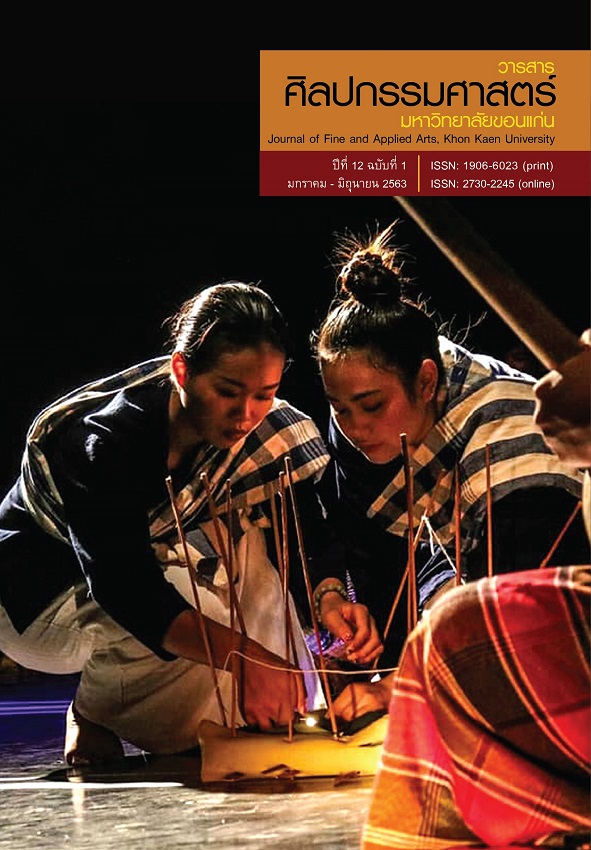The Reflection of the Belief in Nagaraja through an Buddha Buja Leela Nagaraja
Main Article Content
Abstract
This article illustrates people’s homage paid to Nagaraja in a from of the an Buddha Buja Leela Nagaraja dances, which were inspired by the strong belief in Nagaraja, in both northern and southern Isan. The author aimed to study people’s belief in Nagaraja via the reflections from the folk dances of Isan. Methodology used were filed surveys, specifically in Nong Khai province. The results showed that Nagaraja is redeemed as the ideal animal for people in Mekong river basin region. The people have long been bonded with Nagaraja and they immensely believe in its supernatural power of which can bring about prosperity to the land. There are numbers of evidence reflecting on such strong belief including folk tales, legends, sculptures, paintings, spiritual ceremonies, and folk dances. Nong Khai local dance club has created a show, particularly dedicated to Nagaraja, called “Buddha Buja Leela Nagaraja,'' being inspired by its delicate movements along the Mekong river and the lanterns which, according to legends, are projected from its mouth. This show is annually performed in Wan Ok Phansa, the last day of the three-month annual retreat observed by Theravada practitioners. The accompanying music shows the beautiful local identities, and
the costumes are inspired by the sculptures and paintings connected to the sacred Nagaraja.
Article Details
Content and information in articles published in the Journal of Fine and Applied Arts of Khon Kaen University is regarded as the opinion and sole responsibility of the author(s) directly; therefore, editors are not obliged to agree to or share any responsibility with regard to the content and information that appears within these articles.
All articles, information, content, image, etc. that have been published in the Journal of Fine and Applied Arts of Khon Kaen University is the copyright of the Journal of Fine and Appllied Arts of Khon Kaen University. Any person or organization who wishes to distribute all or parts of the articles for further dissemination or other usage must first receive permission from the Journal of Fine and Applied Arts of Khon Kaen University before proceeding to do so.
References
กัญญรัตน์ เวชชศาสตร์. (2559). มโนทัศน์เรื่องนาคของชนชาติไท. นครปฐม: มหาวิทยาลัยศิลปากร.
กิตติสันต์ ศรีรักษา. (2558). ศิลปกรรมรูปนาคหลวงพระบาง: รูปแบบ คติสัญลักษณ์ และการให้ความหมายในฐานเมืองมรดกโลก. วิทยานิพนธ์ปริญญาดุษฎีบัณฑิต สาขาวิจัยศิลปะและวัฒนธรรม คณะศิลปกรรมศาสตร์ มหาวิทยาลัยขอนแก่น.
ชมรมนาฎศิลป์หนองคาย. (2562). พุทธบูชา ลีลานาคราช. ค้นเมื่อ 15 ตุลาคม 2562, จาก https://www.facebook.com/NONGKHAIDRAMATICARTCLUB
ชาญชัย คงเพียรธรรม. (2558). การศึกษาวิเคราะห์สัญลักษณ์สัตว์ในวัฒนธรรมเขมร: การคงอยู่และการเปลี่ยนแปลง. อุบลราชธานี: คณะศิลปศาสตร์ มหาวิทยาลัยอุบลราชธานี.
เสียง “มหาพุทธบูชา นาคะประทีป นาฎนันทการ” ในงานเทศกาลออกพรรษาบั้งไฟพญานาค จังหวัดหนองคาย ประจำปี 2562.
วิกิพีเดีย สารานุกรมเสรี. (2562). คันทวย. ค้นเมื่อ 1 ตุลาคม 2562, จาก https://th.wikipedia.org/wiki/คันทวย
วิเชียร นามการ. (2554). การศึกษาอิทธิพลความเชื่อเรื่องพญานาคที่มีผลต่อสังคมไทยปัจจุบัน. วิทยานิพนธ์ปริญญาพุทธศาสตรมหาบัณฑิต สาขาพระพุทธศาสนา บัณฑิตวิทยาลัย มหาวิทยาลัยมหาจุฬาลงกรณราชวิทยาลัย.
ศูนย์วัฒนธรรม มหาวิทยาลัยขอนแก่น. (2562). วัฒนธรรมและประเพณี. ค้นเมื่อ 5 ตุลาคม 2562, จาก http://cac.kku.ac.th/?page_id=88
แอ๊ด บูรพา. (2546). ร่องรอยนาคา. กรุงเทพฯ: แสงพระอาทิตย์.


